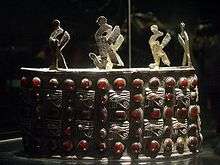Walter Bryan Emery
Walter Bryan Emery (2 July 1902 – 11 March 1971)[1] was a British Egyptologist born in Liverpool, England. Before his career in Egyptology began, he was introduced into the study of marine engineering where he became an excellent draftsman, which resulted in the brilliantly executed line drawings that permeated his later published works on Egyptology.[2] With the exception of six years in the British Army during the Second World War, followed by four years in the Diplomatic Service at Cairo in Egypt, his entire life was devoted to the excavation of archaeological sites along the Nile Valley.[3]

After preliminary training at the Liverpool Institute of Archaeology, he went to Egypt for the first time as an assistant on the staff of the Egypt Exploration Society expedition in 1923. There he aided in the excavation of Amarna (the ancient city in Middle Egypt founded by the pharaoh Akhenaton).[3]
By 1924, he was already Field Director of Sir Robert Mond's excavations at Thebes for the University of Liverpool. He made several clearings, restorations and protective operations into a score of tombs at Sheikh Abd el-Gurnah. Between 1924 and 1928, continuing as Director of the Mond Expedition, he worked on excavations at Nubia, Luxor and Thebes.[4]
In 1929 he was appointed Field Director of the Archaeological Survey of Nubia under the auspices of the Egyptian Government Service of Antiquities, with authority to explore and excavate all ancient sites in Nubia which were soon to be flooded after the erection of the Aswan Dam.[5] Working at Quban, Ballana and Qustul, he excavated the mysterious X group of tombs dating to the 3rd to 6th century A.D. He was assisted in his work by his wife, Molly.[4] The completion of the excavations of the fortress at Buhen ended his work in Nubia.[3]
He then became director of fieldwork at Luxor and Armant. During the years 1935 to 1939 he was the director of the Archaeological Survey of Nubia. During these years as director, Emery also investigated several early dynastic tombs at Saqqara. While at Saqqara he made the significant discovery of a "zoo" of mummified animal remains.
Following the years of interruption by the war and his service as a diplomat, Emery worked in the Sudan (Buhen, Qasr Ibrim). In 1964, he returned once more to Saqqara where he discovered the "enclosure of the sacred animals".[5] In 1970 the discovery was announced of a "mausoleum of the sacred cow," one of the most important finds in the annals of Egyptology.[3]
Emery obtained the Chair of Egyptology at University College London in 1951, and was a professor of Egyptology in London from 1951 to 1970.[4] He was elected to the British Academy Fellowship in 1959. His principal publications are Great tombs of the 1st dynasty, (3 volumes) 1949-58; Archaic Egypt, 1961; and Egypt in Nubia, 1965.[6]
Emery died in March 1971.
Bibliography
Emery published a number of works, including:
- 1938 ''Excavations at Saqqara - The Tomb of Hemaka. Government Press, Cairo
- 1939 Hor-aha, Cairo
- 1949 Great Tombs of the First Dynasty I, Cairo
- 1954 Great Tombs of the First Dynasty II, London
- 1958 Great Tombs of the First Dynasty III, London
- 1961 Archaic Egypt, Edinburgh
- 1962 A Funerary Repast in an Egyptian Tomb of the Archaic Period, Leiden
References
- ↑ H.S. Smith: Walter Bryan Emery, The Journal of Egyptian Archaeology, Vol.57 (1971), pp.190-201
- ↑ "Saqqara". Francesco Raffaele. 1999. Retrieved 2008-01-20.
- 1 2 3 4 Archaic Egypt (bio), Walter B. Emery, Pelican Books, London, 1963.
- 1 2 3 Katherine Tumer (2003). "Walter Bryan Emery". Minnesota State University Museum. Retrieved 2008-02-03.
- 1 2 Saqqare Online. "Walter Bryan Emery". Profiles. Retrieved 2009-06-16.
- ↑ "Archaic Egyptian Art". R & T Enterprises Ltd. 1997–2004. Retrieved 2008-02-11.